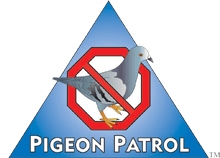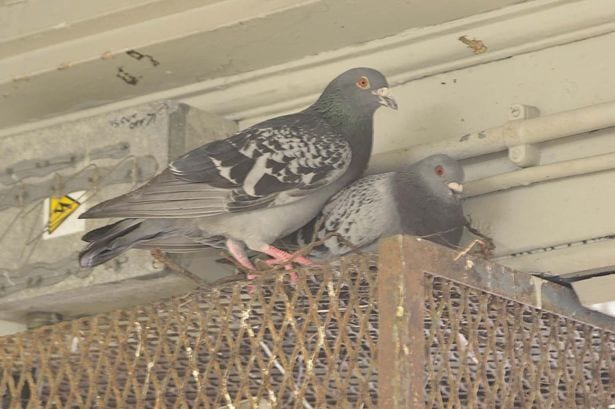
by Pigeon Patrol | Jun 11, 2015 | Pigeon Patrol's Services, Pigeons in the News
 Trapped with no way out – at risk of losing their lives – creating fears of a health risk to people nearby…relax. We’re talking about pigeons here.
Trapped with no way out – at risk of losing their lives – creating fears of a health risk to people nearby…relax. We’re talking about pigeons here.
Pigeons. They’re just rats with feathers, right? But nobody wants to see them suffer, even if they are trespassing. The birds apparently got caught between the roof of a strip mall and a drop ceiling in a hair salon during a renovation job.
Employees at the Style America salon at Central and Tramway removed some of the ceiling panels, hoping that the birds would fly down and out the door. No luck. The fat little knuckleheads just squat up there doing what pigeons do – which leads to worries about illness and disease from pigeon poop.
“With some basic precautions, unless you’re going to put yourself right in contact with it, there’s really very little risk,” said biologist Justin Stevenson who runs a Los Lunas-based company called RD Wildlife Management. “That’s based on a tremendous amount of science and research, which is what we base everything on.“
Stevenson did say people with immune system issues do need to worry about even small amounts of pigeon droppings. He said that based on his experience, there is probably a way in and out for the pigeons, and people in the building see them roosting and think they’re trapped. He said if in fact they are trapped, he will conduct a rescue operation for free.
A Style America customer said she called City Hall at 311 to get some help, but learned that the city is not in the business of removing pigeons from private property. It’s up to the owner or the tenants to deal with it.
About Pigeon Patrol:
Pigeon Patrol Products & Services is the leading manufacturer and distributor of bird deterrent (control) products in Canada. Pigeon Patrol products have solved pest bird problems in industrial, commercial, and residential settings since 2000, by using safe and humane bird deterrents with only bird and animal friendly solutions. At Pigeon Patrol, we manufacture and offer a variety of bird deterrents, ranging from Ultra-flex Bird Spikes with UV protection, Bird Netting, 4-S Gel and the best Ultrasonic and audible sound devices on the market today.
Voted Best Canadian wholesaler for Bird Deterrent products four years in a row.
Contact Info: 1- 877– 4– NO-BIRD (www.pigeonpatrol.ca)
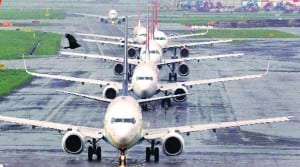
by Pigeon Patrol | Jun 2, 2015 | Bird Deterrent Products, Pigeon Patrol's Services, Pigeons in the News
 Despite measures in place at the Chhatrapati Shivaji International Airport to keep birds away, bird strikes have gone up over the years, shows data. In 2014, around 67 suspected bird strikes at the Mumbai airport were reported to the Directorate General of Civil Aviation (DGCA), up from 49 suspected bird strikes in 2013.
Despite measures in place at the Chhatrapati Shivaji International Airport to keep birds away, bird strikes have gone up over the years, shows data. In 2014, around 67 suspected bird strikes at the Mumbai airport were reported to the Directorate General of Civil Aviation (DGCA), up from 49 suspected bird strikes in 2013.
The growing number forced the Mumbai International Airport Pvt Ltd (MIAL) to purchase an avian-deterrent variety of grass recently to plant near the runway on a trial basis.
Pariah kites, pigeons, common myna, egrets and crows are some of the birds involved in bird strikes at the airport, according to MIAL.
When an aircraft makes the final approach towards the airport, these birds are likely to hit the aircraft.
Avian-deterent Ryegrass, purchased by MIAL, has natural fungus in the form of endophyte, which produces chemicals that deter insect growth. According to the Association of Private Airport Operators, while bird strikes lead to losses of over Rs 20 crore annually to the Indian aviation industry, they are also a serious threat to passenger safety.
“A 30-lbs goose striking the windscreen of a plane flying at 200 knots (in circuit speed) creates a relative impact of 20 tonne, which could cause serious damage to aircraft and pose a risk to the lives of passengers. The civic authorities never pay attention to environmental issues when it comes to airline operations,” said Captain Mohan Ranganathan, an aviation safety expert.
There are approximately 250 slaughterhouses near the airport, which attract birds in the area, besides the garbage ‘hill’ at the Deonar dumping ground that lies in the approach funnel of the Mumbai airport.
“Besides the Deonar garbage hill attracting birds, flowing near the airport is the filthy Mithi river. Further, within the airport, there are open drains, making it a haven for birds,” said Dr Satish Pande, director of Ela Foundation, an NGO. MIAL has asked the NGO to conduct a survey to understand the behaviour of birds in the 10-km radius of the airport (risk zone), and suggest solutions to avoid bird strikes.
“There is also a small bat colony in front of terminal 1-B and these bats leave their roost at night. We have proposed trimming of trees to dissuade such colonies after taking all necessary permission,” said Pande, whose report will be submitted to MIAL this month.
Besides bursting crackers, MIAL uses launchers and cartridges that cause an exploding and whistling sound, and vehicle mounted scarecrow during the day. At night, laser bird repellent torches are used to scare birds during poor visibility.
About Pigeon Patrol:
Pigeon Patrol Products & Services is the leading manufacturer and distributor of bird deterrent (control) products in Canada. Pigeon Patrol products have solved pest bird problems in industrial, commercial, and residential settings since 2000, by using safe and humane bird deterrents with only bird and animal friendly solutions. At Pigeon Patrol, we manufacture and offer a variety of bird deterrents, ranging from Ultra-flex Bird Spikes with UV protection, Bird Netting, 4-S Gel and the best Ultrasonic and audible sound devices on the market today.
Voted Best Canadian wholesaler for Bird Deterrent products four years in a row.
Contact Info: 1- 877– 4– NO-BIRD (www.pigeonpatrol.ca)
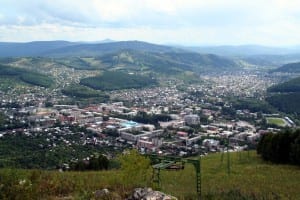
by Pigeon Patrol | Mar 31, 2015 | 4-S Gel Bird repellent, Animal Deterrent Products, Bird Netting, Pigeon Patrol's Services, Pigeons in the News
 Three oil sands companies say scores of birds were killed after landing at their waste facilities in east-central Alberta, Canada, even though their avian deterrents were operational at the time.
Three oil sands companies say scores of birds were killed after landing at their waste facilities in east-central Alberta, Canada, even though their avian deterrents were operational at the time.
All three companies – Canadian Natural Resources Ltd. (CNRL), Syncrude and Suncor – said the birds began landing the morning of Nov. 4 and that their wildlife deterrents were working properly at the time. However, a dense fog was reported at the time, which may have disoriented the birds, contributing to their deaths.
All told, 122 waterfowl died on the companies’ tailing ponds, where waste from oil extraction is dumped, the Alberta Energy Regulator (AER) reported on Nov. 5. CNRL reported finding 60 dead birds at its Horizon site, and Syncrude said it had to euthanize 30 birds that landed on a similar facility at its Mildred Lake site.
Suncor said that about 120 birds closed in on one of its waste ponds at about the same time, but its deterrents frightened most of them away. Six, though, managed to land.
Investigators sent in by the AER are trying to determine whether the companies’ deterrents were, in fact, working that day. The deterrents include ordinary scarecrows as well as more high-tech devices as radar units and acoustic devices such as propane cannons, which shoot nothing more dangerous than noise, to scare wildlife from toxic areas.
The oil companies expressed concern about the birds’ deaths. CNRL spokeswoman Julie Woo said in an e-mail to Canadian Broadcasting Corp. News, “We are saddened that approximately 60 waterfowl were not deterred and we are currently in the process of confirming the final affected number.”
Will Gibson of Syncrude offered a similar sentiment. He said his company noted increased bird activity in the region that morning. “As a result of these observations,” he told Global News, “our bird deterrent system went into heightened alert.”
“We don’t want our operations to harm wildlife,” Gibson said, “so we’re going to be reviewing our systems to see if there’s additional areas to improve on what we’ve already implemented.”
Syncrude, a major oil sands operator in the region, was hit with a $3 million fine for the deaths of more than 1,600 ducks that had landed on its tailings pond in 2008.
Mike Hudema of Greenpeace Canada says wildlife deterrent systems aren’t enough, and that the oil sands operations need to get rid of tailings ponds, period. “The systems that they put in place to try to keep birds off are not working,” he said. “The only way to keep birds and animals safe in, really, what is a toxic brew of chemicals is to get these tailings ponds off the Alberta landscape.”
AER spokesman Ryan Bartlett said his agency is investigating the incident, but the results may not be known for months. Meanwhile, neither Alberta’s Environment or Energy ministry would comment, leaving the matter to AER. Provincial Premier Jim Prentice said he’d have nothing to say until the AER issues a report on its investigation.
About Pigeon Patrol:
Pigeon Patrol Products & Services is the leading manufacturer and distributor of bird deterrent (control) products in Canada. Pigeon Patrol products have solved pest bird problems in industrial, commercial, and residential settings since 2000, by using safe and humane bird deterrents with only bird and animal friendly solutions. At Pigeon Patrol, we manufacture and offer a variety of bird deterrents, ranging from Ultra-flex Bird Spikes with UV protection, Bird Netting, 4-S Gel and the best Ultrasonic and audible sound devices on the market today.
Voted Best Canadian wholesaler for Bird Deterrent products four years in a row.
Contact Info: 1- 877– 4– NO-BIRD (www.pigeonpatrol.ca)
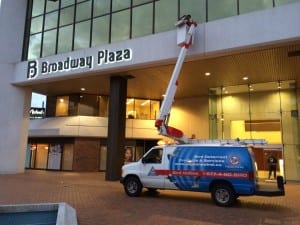
by Pigeon Patrol | Mar 31, 2015 | 4-S Gel Bird repellent, Bird Deterrent Products, Pigeon Patrol's Services, Pigeon Spikes, Pigeons in the News
 FAIRBANKS — One of the places where pigeons congregate downtown is the parking garage on Lacey Street.
FAIRBANKS — One of the places where pigeons congregate downtown is the parking garage on Lacey Street.
Twice per year, a parking garage employee must put on a Tyvek suit, wear a respirator and scrape about 75 gallons of pigeon dung from the concrete floors.
The droppings are loaded into thick bags and disposed of in the hazardous materials area at the landfill.
“Pigeon crap weighs a ton,” said Marcus Dodge, executive director of the Fairbanks Parking Authority. “It’s not a lot of fun to clean up.”
Dodge has noticed in recent years the downtown pigeon population seems to be growing. Others agree. Businesses are experimenting with ways to deter the bird.
The pigeons are a nuisance, Dodge said, and their poop is damaging property.
The droppings contain ammonia and uric acids that are eating away at the sealant on the parking garage’s concrete floor.
The pigeon guano also contains communicable diseases, though the risk of catching a disease from pigeon poop is low.
One pigeon can produce up to 25 pounds of guano per year, according to a government report “Curbing the Pigeon Conundrum,” detailing the pigeon problem in New York City.
A hatch on a Swedish church tower inadvertently left open since the 1980s resulted in two tons of pigeon droppings collecting in the tower, according to news reports.
Pigeon droppings are blamed for speeding the decay of a bridge in Minneapolis that collapsed in 2007, killing 13 people and injuring many more.
In Fairbanks, roofers last summer discovered six inches of pigeon dung on the roof of the Courthouse Square, a maintenance worker said.
Cathie Harms, spokeswoman for the Alaska Department of Fish and Game, said pigeons were brought to Fairbanks by hunters and dog trainers. They are not a native bird.
“Pigeons are pretty darn flexible,” Harms said. “They will eat a variety of food. They are prolific breeders. They will roost anywhere they can get a degree of shelter.”
Charlie Cole, who has kept an office in downtown Fairbanks since 1957, said he has noticed the pigeon problem is getting worse.
Cole didn’t pay much attention to the bird until recent years, he said.
They are nesting near his building, and Cole has been talking with his neighbors about collaborating to fend off the bird.
“They leave droppings around warm air outlets where they congregate,” said Cole, a former Alaska Attorney General. “I think it’s a nuisance.”
A couple of months ago, a maintenance worker for the Springhill Suites Marriot decided to try a recording of predator birds to deter pigeons from gathering on the eaves of the hotel.
The recording could be heard a couple of blocks away and annoyed some of the hotel’s neighbors.
“The machine is off,” said Penny Cotten, vice president of marketing and communications for the company that manages the hotel. “There is no point. It doesn’t work. People don’t like it.”
Architect David Whitmore, who owns a building on Third Avenue, said 15 to 20 pigeon nests were discovered in the gap where the corner of his building meets three neighboring buildings.
“It’s poopsville,” said Whitmore, who is thinking of putting a net over the gap so the pigeons move on.
Whitmore is indifferent to the pigeon problem.
“It’s always good to have tolerance with animals,” he said. “We’re in this community together.”
Robert Franklin, a maintenance foreman for JL Properties Inc., which manages the Courthouse Square and the Northward apartment building, has a different point of view. He describes pigeons as flying rats.
Pigeons make extra work for guys like Franklin.
“They’re a hazard to the equipment. They’re a hazard to people,” he said. “They get into stuff they are not supposed to.”
Franklin uses spike strips and owl decoys to repel pigeons with mixed success, he said.
He moves the owl decoys once the pigeons get used to them.
Harms said the best way to deter pigeons is to eliminate their source of food.
“We are aware that some people are feeding pigeons,” she said. “If there wasn’t as much food, there wouldn’t be as many pigeons.”
Pigeon Patrol Products & Services is the leading manufacturer and distributor of bird deterrent (control) products in Canada. Pigeon Patrol products have solved pest bird problems in industrial, commercial, and residential settings since 2000, by using safe and humane bird deterrents with only bird and animal friendly solutions. At Pigeon Patrol, we manufacture and offer a variety of bird deterrents, ranging from Ultra-flex Bird Spikes with UV protection, Bird Netting, 4-S Gel and the best Ultrasonic and audible sound devices on the market today.
Voted Best Canadian wholesaler for Bird Deterrent products four years in a row.

by Pigeon Patrol | Mar 19, 2015 | Animal Deterrent Products, Bird Deterrent Products, Pigeon Patrol's Services, Pigeons in the News
 Bird fans are in a flap after there appeared to be fewer of the feathered inhabitants around Redhill’s shopping area and station in recent weeks.
Bird fans are in a flap after there appeared to be fewer of the feathered inhabitants around Redhill’s shopping area and station in recent weeks.
Natalee Spencer, 20, said she feared for the birds’ safety when they did not take the food she left.
She told the Mirror: “I was wandering through the town centre on my way to work one day when I noticed I couldn’t see many of them.
“I sometimes put some food out for them because they need to eat too. But I couldn’t see any of them around so I just left the food on the ground.
“That night I went to Sainsbury’s with my dad and the food was still there. It hadn’t been touched. I was worried there had been a cull or something.”
Others have also noticed the area around Redhill Station, once littered with pigeon droppings, is now clearer.
Daniel Nixon, 36, who works in the area, said: “I have noticed the pavement is cleaner these days; there doesn’t seem to be so many birds chilling out overhead.” “Pigeons have no predators and they have an easy life with food easy to find.
“If their easy life has been disturbed by roosting being made more difficult or less food being available, then they might have simply gone somewhere else where it is easier for them.”
He added the pigeons could have caught a bug which depleted the population, but could not be sure without investigating.
In response to concerns about bird droppings on the pavement, Network Rail said it would look into installing new measures, such as mesh or nets, to deter the birds.
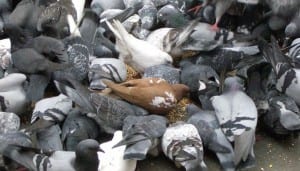
About Pigeon Patrol:
Pigeon Patrol Products & Services is the leading manufacturer and distributor of bird deterrent (control) products in Canada. Pigeon Patrol products have solved pest bird problems in industrial, commercial, and residential settings since 2000, by using safe and humane bird deterrents with only bird and animal friendly solutions. At Pigeon Patrol, we manufacture and offer a variety of bird deterrents, ranging from Ultra-flex Bird Spikes with UV protection, Bird Netting, 4-S Gel and the best Ultrasonic and audible sound devices on the market today.
Voted Best Canadian wholesaler for Bird Deterrent products four years in a row.
Contact Info: 1- 877– 4– NO-BIRD (www.pigeonpatrol.ca)
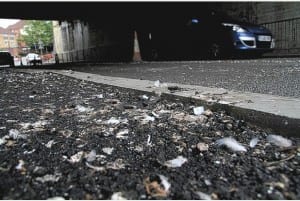
by Pigeon Patrol | Mar 19, 2015 | 4-S Gel Bird repellent, Bird Deterrent Products, Pigeon Patrol's Services, Pigeon Spikes, Pigeons in the News
 Twice a year, Marcus Dodge assigns a worker to don disposable coveralls and a respirator for a trip to a downtown Fairbanks parking garage to clean up deposits from a non-native species.
Twice a year, Marcus Dodge assigns a worker to don disposable coveralls and a respirator for a trip to a downtown Fairbanks parking garage to clean up deposits from a non-native species.
Dodge, director of the Fairbanks Parking Authority, estimates the worker picks up 150 gallons of pigeon dung annually and hauls it to the hazardous materials area at the landfill.
“Pigeon crap weighs a ton,” Dodge said. “It’s not a lot of fun to clean up.”
The downtown pigeon population appears to be growing, according to Dodge and others. Businesses are experimenting with ways to deter the birds.
Roofers last summer discovered 6 inches of pigeon guano on the roof of the Courthouse Square, the former federal courthouse.
Charlie Cole, Alaska’s former attorney general, who has kept an office in downtown Fairbanks since 1957, has been talking with neighbors about fending off the birds.
“They leave droppings around warm air outlets where they congregate,” Cole said. “I think it’s a nuisance.”
Pigeon droppings contain ammonia and uric acids that eat away at metal and the sealant on the parking garage concrete floor.
One pigeon can produce 25 pounds of guano per year, according to a government report detailing New York City’s pigeon problem. The droppings were cited as possible cause for speeding the decay of a Minneapolis bridge across the Mississippi River that collapsed in 2007 and killed 13 people.
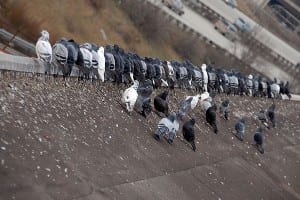 Hunters and dog trainers introduced pigeons to Fairbanks, said Cathie Harms, spokeswoman for the Alaska Department of Fish and Game. The best way to deter them, she said, is to eliminate their food source.
Hunters and dog trainers introduced pigeons to Fairbanks, said Cathie Harms, spokeswoman for the Alaska Department of Fish and Game. The best way to deter them, she said, is to eliminate their food source.
“We are aware that some people are feeding pigeons,” she said. “If there wasn’t as much food, there wouldn’t be as many pigeons.”
A maintenance worker for the Springhill Suites Marriot a few months ago tried chasing them off with a recording of predator birds. The sound could be heard from a couple of blocks away and drew complaints from hotel neighbors.
Robert Franklin, a maintenance foreman for JL Properties Inc., which manages the Courthouse Square and the Northward apartment building, calls pigeons flying rats.
“They’re a hazard to the equipment. They’re a hazard to people,” he said. “They get into stuff they are not supposed to.”
He uses spike strips and moves owl decoys around to repel pigeons. Success has been mixed, he said.
About Pigeon Patrol:
Pigeon Patrol Products & Services is the leading manufacturer and distributor of bird deterrent (control) products in Canada. Pigeon Patrol products have solved pest bird problems in industrial, commercial, and residential settings since 2000, by using safe and humane bird deterrents with only bird and animal friendly solutions. At Pigeon Patrol, we manufacture and offer a variety of bird deterrents, ranging from Ultra-flex Bird Spikes with UV protection, Bird Netting, 4-S Gel and the best Ultrasonic and audible sound devices on the market today.
Voted Best Canadian wholesaler for Bird Deterrent products four years in a row.
Contact Info: 1- 877– 4– NO-BIRD (www.pigeonpatrol.ca)

 Trapped with no way out – at risk of losing their lives – creating fears of a health risk to people nearby…relax. We’re talking about pigeons here.
Trapped with no way out – at risk of losing their lives – creating fears of a health risk to people nearby…relax. We’re talking about pigeons here.